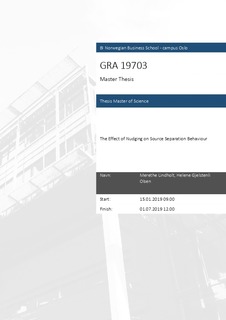| dc.description.abstract | This research aimed to study whether nudges through general visuals
prompt and social norms through framing would increase the amount of source
separated waste in kilos. Also, we included the element of time to see whether
additional time would strengthen the effect of the nudges. The participants
included in this study were primarily students, faculty, staff, and visitors who used
the source separation stations at the business school. The data was collected by
sorting the content collected from predetermined source separation stations before
weighing correctly and incorrectly sorted waste. The results indicated that there
was a statistically significant difference in correctly source separated waste
between baseline and each of the three treatments. Gastro location had a
significant effect on both food and plastic waste. Starbucks location had a
significant effect on food waste, while Amigo location had a significant effect on
trash waste. In total, when considering all of the different locations, food waste
had a significant effect of p =, 001 overall conditions. Trash waste equalled p =,
150, and plastic waste had p =, 021, meaning that a significant effect was found in
food and plastic waste overall conditions, but not in trash waste. However, the
results from the significance levels between each condition indicated additional
information in that although there were effects, especially when making
comparisons between baseline and the interventions. When comparing the effect
sizes between the different interventions, the results indicated that the location
Gastro cafeteria had significant values in some of the comparisons in concern to
food and plastic waste. In the Starbucks coffee shop location, food waste was the
only type of waste that had significant results, and only when comparing baseline
with the second intervention. Lastly, in the Amigo kiosk location trash and plastic
waste was found to be statistically significant in some comparisons between
conditions. Although this study can report that the nudges did have an impact, the
effect was not found to be statistically significant in concern to the hypotheses
linear demands. Implications and suggestions for future research will be
discussed. | nb_NO |
